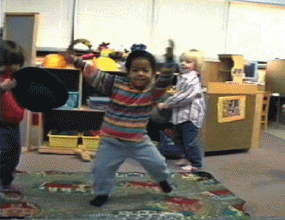She Changes Her Movements to Fit the Music

Have you ever seen a child who seems a bit advanced when it comes to moving to the music? We all recognize such cases when we see them, but what is it that they know? Can we be more explicit about why their moves are a bit more impressive than ordinary? Watch this three-year old dance to two different songs, one about the mambo, the other about the limbo. Watch her all the way through (around two minutes). Then revisit segments and identify the subtleties of what she is doing so that we can begin to talk about dance as more than fun, which of course it is, but also dancing can reveal a form of intelligence in action (see Howard Gardner's work on Multiple Intelligences: Bodily-Kinesthetic).
Here are some moves to notice:
• How she centers herself and approaches the camera to present her dance.
• Her half-time pirouette showing she can “over-ride” the strong beat of the music.
• Her ability to shift energy and pattern multiple times in short order.
• Her use of half-steps to accentuate the upbeat of the music.
• Her paradoxical moves of dancing while not standing (floor moves).
• Her change of the contour of her arms to replicate the stoop of her legs.
• Her ability to do minor movements within major movements, such as a head wobble while she shifts weight from foot to foot.
You will no doubt see things that this analysis missed and possibly disagree with some items in this list. But do think about what it means to know when a child is being clever. Intelligence cannot be understood simply by ranking the focus, persistence, curiosity, joy, and motivation of a child. We need to describe what a child does.
